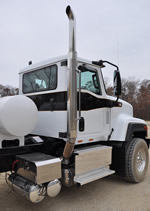Growing adoption of clean diesel systems utilizing Selective Catalytic Reduction (SCR) technology is reducing emissions and increasing fuel efficiency in heavy-duty trucks and smaller vehicles, according to Diesel Technology Forum Executive Director Allen Schaeffer.
“SCR-based systems are helping manufacturers balance the competing goals of lower emissions and increased fuel efficiency. They are a ‘game-changer’ that helps ensure clean diesel power is the technology of choice for the foreseeable future,” he told 7th Integer Emissions Summit USA in Chicago. Of the 250,000 new commercial heavy-duty trucks sold in 2014, he notes, more than more than 95 percent were powered by SCR exhaust aftertreatment-equipped clean diesel power.
An increasing number of engines, vehicles and equipment are utilizing SCR, and the systems are performing as designed and helping to slash the diesel fuel costs for truckers and others using the new generation of clean diesel, Schaeffer observes, adding: “The U.S. Environmental Protection Agency and National Highway Traffic Safety Administration will issue what is already a closely-watched proposal that will establish higher fuel efficiency requirements from commercial trucks in the years ahead.”
Widely deployed in Class 8 trucks to meet sharply reduced Environmental Protection Agency emissions and particulate matter thresholds for on-highway diesel engines beginning in 2010, SCR is an advanced active emissions control technology system that injects a liquid reductant agent through a special catalyst into the exhaust stream of a diesel engine. The reductant source is usually automotive-grade urea, otherwise known as diesel exhust fluid. The DEF sets off a chemical reaction that converts nitrogen oxides (NOx) into nitrogen, water and tiny amounts of carbon dioxide, which is then expelled through the vehicle tailpipe.
SCR technology is designed to permit NOx reduction reactions to take place in an oxidizing atmosphere. It is called “selective” because it reduces levels of NOx using ammonia as a reductant within a catalyst system. The chemical reaction is known as “reduction” where the DEF is the reducing agent that reacts with NOx to convert the pollutants to inert tailpipe compounds. The DEF can be rapidly broken down to produce the oxidizing ammonia in the exhaust stream. SCR technology alone can achieve NOx reductions up to 90 percent. — www.dieselforum.org
